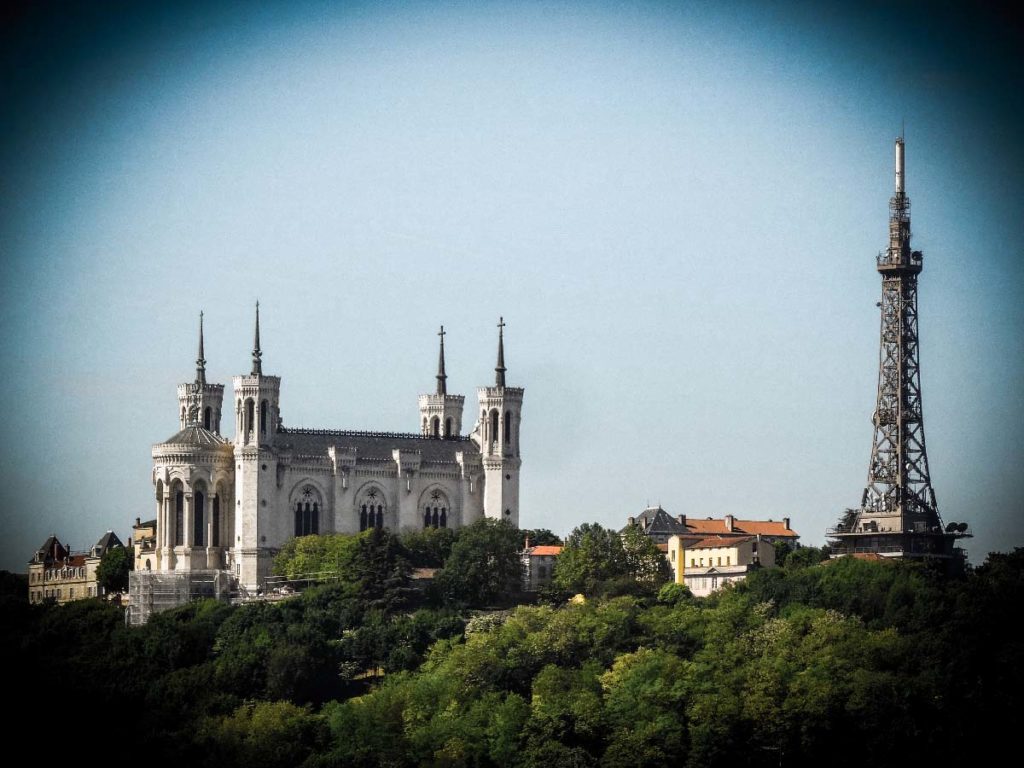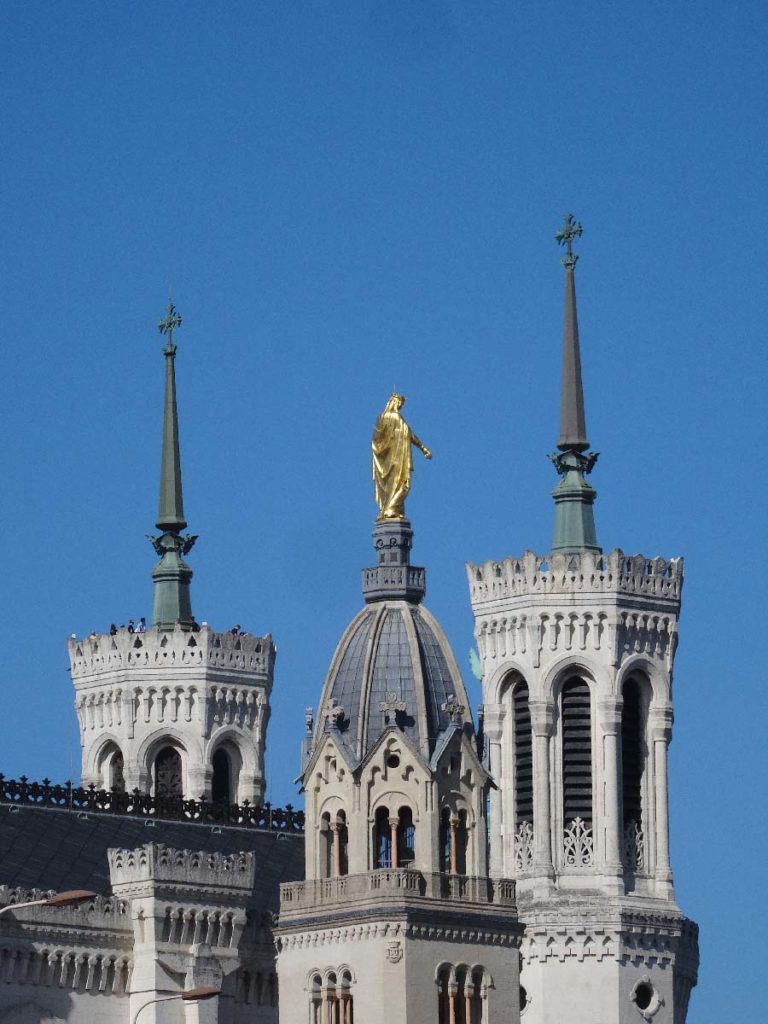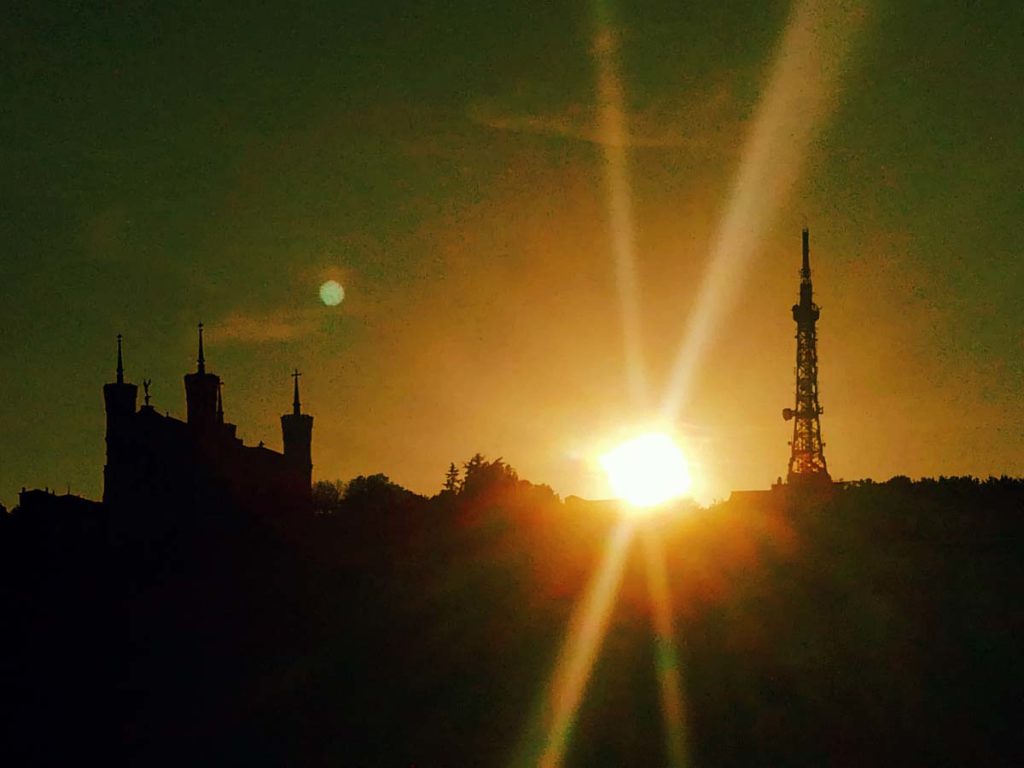You might have seen it from afar, watching over Lyon from high up… But what exactly is that huge church that seems to dominate the city? Well, you probably guessed it, it’s the basilica of Notre-Dame de Fourvières – after all, you clicked on the link for a reason!

The Basilica, a huge, 19th century building, is one of the main landmarks of Lyon : probably because it had everything to become the symbol of Lyon’s Christianity, but also a communal symbol, anchoring in the stone some of the city’s traditions and history. It is also a main place for the worship of Mary, a special kind of worship in Lyon which finds its origin in the special relation between Lyon and the Holy Mother.
But, What is the story of this magnificent building?
If you just want to know what to see and practical information, you can skip to the end
Once upon a time, a man in his late youth travels to Italy…
Once upon a time there was a man in Lyon who had worked on a few architectural projects. He was rather free-minded, and cared not much for spiritual things. Because he dreamt of fortunes, he traveled to Sicily with his brother. Living in Palermo, he discovered the beauties of Southern Italian architecture; beauties that eventually became his architectural influences.
But his travels eventually cost him a lot… During the siege of Palermo – between 1848 and 1849 – a plague rampaged the city. The architect’s brother suddenly fell ill, and died the following day. Because of war and illness, no one would help him with his brother’s body. He then dug a grave with his bare hands, where he left his brother’s body. Traumatised, he left Palermo for Rome where he stayed for a while.
Shortly after that, in 1850, he came back to Lyon, with a project maturing in his mind: he had drawn a first plan for a new, huge church that would be erected on the top of Lyon’s Fourvière district. This was his new dream.
This man was Pierre Bossan.
A very long time ago, in Lyon, the Virgin Mary bestowed her grace upon Lyon…
In Lyon, since the Middle-Ages, the hill of Fourvière had been dedicated to the Virgin Mary. The old church on Fourvière hill, the Saint-Thomas Chapel, had been a place of pilgrimage to ask the Holy Mother for favours and help. A French King, Louis XIII, even came to honour Mary when he visited Lyon in 1476. Therefore, it would only be natural to the people of Lyon that when came dire times, they would walk on top of the hill and shower Mary with gifts in exchange for help.
Mary saved Lyon from the plague
So when a first plague in 1638 started decimating the orphans of Lyon, the local clergy climbed up the Fourvière church and showered the Virgin Mary with gold and candles. They promised to erect two statues in Her honour if she got rid of the disease in the city. And they got blessed! The disease suddenly disappeared! Then, only a few years later, in 1643, another plague appeared on the outskirts of the city. The city council, medical personnel, and clergymen re-expressed their wishes to the Virgin Mary. And they were blessed again! The plague never spread in the city!
Mary and the “Fêtes des Lumières”, or Festival of Lights
Before the construction of the Basilica, the Saint-Thomas Chapel on Fourvières was already a hotspot for the worship of Mary. Hence, a testimony to that is the “Fêtes des Lumières”, or Festival of Lights.

Indeed, in 1852, to thank Mary for her protection, they order a golden sculpture to erect on the bell tower of the Saint-Thomas Chapel on Fourvière hill. Initially, the sculpture is supposed to be erected on the 8th of september, for the Nativity of the Blessed Virgin Mary – her birthday, if you will. But the weather is so atrocious in autumn 1852 that they have to postpone the erection of the statue for… 3 whole months!
The 8th of December, rain is pouring, and they postpone the event again. But in the end of the afternoon, as the sun is setting, the rain suddenly stops and a huge rainbow hovers over the hill of Fourvières! It’s a miracle! Although the statue cannot be erected that same day, the whole of Lyon lights up candles for Mary. The show was so beautiful the contemporaries were amazed. And that’s why, every 8th of December, everyone in Lyon would light up candles in memory of Mary’s miracle!
Pierre Bossan comes back to Lyon
Our architect that we left in on his way back to Lyon, is now in his early 40s. He’s marked in his flesh and his mind by the brutality of war and the death of his brother.
After a while at home, both his sisters came to him and expressed their wishes to become nuns. After he had talked with them for a while, he wanted to understand why they would want to enter the Church and live a holy life. They said that a man, the Abbot Vianney (today, the Saint Patron of Abbots), had convinced them to do so.
Therefore, he followed his sisters in Ars, a village in the vicinity of Lyon, to discuss with the man who had such an influence on his family. No one knows exactly what conversation the two men had; but one thing we know for sure is that when Bossan came back to Lyon, he was deeply troubled.
And soon, from troubled, he moved to touched by the grace of Christ! Bossan had a revelation when he talked with the abbot. And that is how his project of a new church on Fourvière became to him not simply an architectural project, but the expression of his newfound love for God and the Virgin Mary, who had bestowed so many favours to his birthplace, the city of Lyon.
Lyon is protected from the Prussian invasion!
Lyon had lived through plagues and had been saved by the Holy Mother: so when came war, Lyon’s people again looked towards Her to be saved. After all, it worked twice already so why not to try another time!
In 1871, Napoleon III was defeated by the Prussians, who took Paris and advanced towards Lyon. First they had conquered Dijon, and now were planning to invade further South…
So the women of Lyon gifted some of their most priced possessions to the Holy Mother, such as their wedding rings, and men walked on top of the hill of Fourvière to express the wish to be protected by Her grace. The clergymen promised that if they were to be saved from the Prussian army, they would erect a new church in honour of Mary. And, blessed again! The Prussians never walked on Lyon. Mary had again bestowed them Her grace again!
And so Bossan now had the opportunity to build the Basilica of Notre-Dame de Fourvière. He who had suffered the trauma and illness and war, he had come to the realization that in Lyon, everyone had been protected from such pains by Her holiness! Hence, as he was now a fervent Christian, he could thank the Virgin Mary for her constant protection. To do so, he built the greatest of churches on the hill of Fourvière!
The Basilica of Notre-Dame de Fourvière is now in the works
Bossan can now focus on his life’s work
Bossan, now appointed to build the Basilica Notre-Dame de Fourvière, retired to the South of France to concentrate on his work as much as the study of the Bible. Because of that he appointed a younger architect to supervise the construction in Lyon: Louis Sainte-Marie Perrin, also a fervent Christian.

Because Bossan’s vision was so deeply influenced by his own life story and the history of Lyon, the style of the Basilica is very peculiar, very personal. Inspired from his travels – themselves reminiscent of his personal tragedies – and from the history of Lyon, the Basilica expresses faith in the protection of Mary against ailments. And it focuses so much on the worship of Mary. The Bishop of Lyon, seeing the advancement of the worksite, expressed concerns that the Church was not focusing on Christ!
A tragic, ignored side to the story
Although the story of Bossan and the Basilica Notre-Dame de Fourvière are epic stories by themselves, they cast a shadow on the reality of Lyon’s life at the time…
In 1831, the Canuts, Lyon’s textile workers, went through a deep crisis linked to the changing of manufacture technologies. They demonstrated and negotiated rights to keep their income coming in and protect themselves from scarcity. But although they seemed to have won their dues, they little by little lost more and more of their income… Until they demonstrated again, in 1834. This time, the authorities were not keen on letting them protest. They were severely repressed by the army, and from then on had to accept scarcity as their reality.
As Lyon’s Basilica was entirely financed by private funds from rich factory owners and gifts made to the church, one can only wonder at the irony of building such a luxurious church in the face of general scarcity.
Most of the Canuts lived on the hill of Croix-Rousse, the other highest point of Lyon. So, when the hill of worker suffered through scarcity and poverty, the hill of Fourvière, or “hill that prays” received huge allocations of funds from the same people that had refused to let workers claim their rights… And now they could see the embodiment of rich Lyonnais’ accumulation of money, built in the stone on the other side of the city. They could see how much the factory owners had actually profited from their repression…
The Basilica of Notre-Dame de Fourvière, a testament to the neo-byzantine style of Bossan
Bossan is consecrated
Sadly, Bossan died in 1888, 8 years before the opening of the church. He is buried in Lyon, in Loyasse’s cemetery, a few meters aways from his greatest work. But his heart is in the Basilica (I mean literally). In the Basilica of Notre-Dame de Fourvière, you can find a plaque in memory of Pierre Bossan and that’s behind this plate that his heart is preserved.
The Basilica becomes the main symbol of Lyon, dominating the city’s landscape. Hence, Bossan’s work found its consecration, and his style is regarded as major representation of 19th century French architecture.
Fourvière: An “eclectic”, “neo-byzantine” church
That is to say, when you visit, keep in mind that Bossan’s church represents a style that is both very popular in France’s 19th century, but also very much Bossan’s own style. Architecture in France’s 19th century is often call “eclectic”, because architects find various inspiration from every era before them.
Think of other famous artworks from the time: the Basilica of the Sacré Coeur on Montmartre, inspired from Byzantine and Orthodox style churches, or the Opera in Paris, mixing gothic and classic elements together. The subgenre of eclectic architecture of Notre-Dame de Fourvière is the “neo-byzantine” style, inspired from Greek and Southern Italian architectures from the Byzantine era – that is, of architecture before the fall of Constantinople and the Ottoman invasion of present-day Turkey, in 1453.
That was a LOT of information…
Yes, I know… But now you know everything you need to appreciate the building!
- You know that the Basilica of Fourvière represents its architect’s faith and personal history!
- You know it was built in honour of the many graces bestowed to Lyon by the Virgin Mary!
- You know the hill of Fourvières and its Basilica are why we celebrate the Festival of Lights!
- You know why the building has a neo-Byzantine style, and that its complex iconography represents the spiritual thoughts of its architect!
What to see while visiting the basilica Notre Dame de Fourvière
As we explained, because of Bossan’s influence from Palermo, the Church has an Orientalist, neo-byzantine style. Bossan studied the style of Sicily’s old churches, which were built during the reign of Norman Kings in the Middle-Ages and early Renaissance. During the Norman dominion, Sicily was a meeting point for every Mediterranean cultures. Architects imported architectural elements from Norman, Italian, Roman, Arab and Byzantine architecture. Hence, the richness of the Basilica’s style comes from the use of elements that have various origins, coming from a very multicultural background.
When visiting, pay attention to the diversity of these elements: for example, the exotic materials (such as green onyx, pink granite from Northern Italy, or Carrare’s white marble), the triangular pediment reminiscent of Roman-style churches, the Roman-style columns inside and outside the building, the geometric patterns inspired from Arabic arts, the mural mosaics in a style that resembles Greek icons… and many more!
Don’t miss the second church below the main one. The main church is dedicated to Mary but you have a whole second church underneath dedicated to Saint Joseph.
On your way to the underground church, you’ll see the plate hiding the heart of the architect Pierre Bossan. You’ll also have the opportunity to read the prayer dedicated to the virgin Mary in many languages. Try to find your own language!
And finally, pay attention to the sculptures on the walls and roof inside and outside of the church. You’ll notice that some of them look weird. Especially on the roof of the second church. Actually, that’s because the church is not finished. Some of the artwork have never been done. Therefore, you’ll see some squared piece of rock instead of beautiful scultures.
And here, a short timeline of the most important events for Fourvière!
- 1638/1643: the Virgin Mary protects Lyon from two plagues
- 1850: Pierre Bossan’s first architectural study for the Basilica of Notre-Dame de Fourvière
- 1852: Lyon’s first Festival of Lights
- 1871: the Virgin Mary protects Lyon from the Prussian invasion
- 1872: the first stone of the Basilica of Fourvière is set
- 1888: Pierre Bossan dies
- 1896: the Church of Notre-Dame de Fourvière opens to the public
- 1897: the Pope Leon XIII consecrates Notre-Dame de Fourvière; it becomes a basilica
- 1998: The district of Fourvière is registered at UNESCO
- 2022: your host is painfully writing this beautiful article for you
- Today: you’re planning to visit! This story should not end without YOU!
In any case, even if it was a bit painful to read, you should now visit! So, shoo, run to the Basilica and visit it! Or, maybe, take the funicular. Running uphill can be tiring!
Practical info
How to access:
By foot
Take the rise (“montée” in French) of Chazeaux, then the rise of Saint Barthélémy. Enter the Jardin du Rosaire (gardens of Rosaire) to your right and climb up to the basilica.
From Saint Paul, take the rise of Saint Barthélémy and climb up to Fourvière.
Careful, the steps are steep!
By cable car (funiculaire)
A cable car takes you to the basilica from the metro. Take the Funiculaire F2 towards Fourvière at the metro station Vieux-Lyon/Cathédrale Saint-Jean.
By car
Take the tunnel Fourvière, then first exit right after the tunnel (direction Vieux Lyon). Take the rise of Choulans, then right at the first redlight.
Opening times:
Grids: 7:00 a.m. to 10:30 p.m.
Basilica: 7:00 a.m. to 7:00 p.m.
Information point: 10:00 a.m. to 12:00 a.m. and 2:00 p.m. to 5:00 p.m.
Gardens: from 7:00 a.m. to 9:30 p.m. in winter and until 11:00 p.m. in summer
Car park: from 5:15 a.m. to 9:30 p.m. the week and from 9:15 a.m. to 9:30 p.m. the weekend
Visit the roof:
From the basilica Notre Dame de Fourvière, you’ll have one of the best view over Lyon. But if you want even better, you can book a visit on the official website of the basilica
Worship
Please remember to be mindful of worshipers while you visit! A little reminder of weekly worshiping events:
Masses
Sunday Masses: 7:30 a.m, 9:30 a.m, 11:00 a.m. and 5:30 p.m.
Sunday Mass Preview: Saturday at 5:30 p.m.
Masses during the week: 7:15 a.m., 11:00 a.m. and 5:30 p.m.
Prayers
Le chapelet: every weekday at 4.30 p.m.
The divine office: Laudes on Thursdays at 7.45 a.m. and Vespers on Sundays in Advent and Lent or big holidays at 4.45 p.m.
And if you want more information on this building or just enjoy while walking in the beautiful streets of Lyon, join us on one of our free walking tour!
